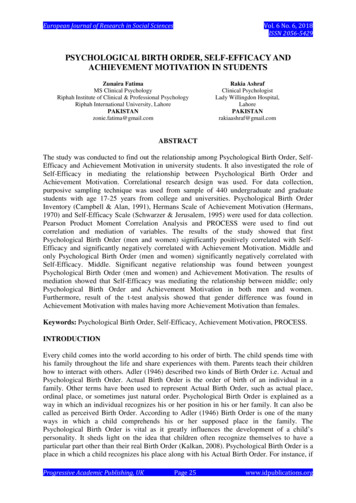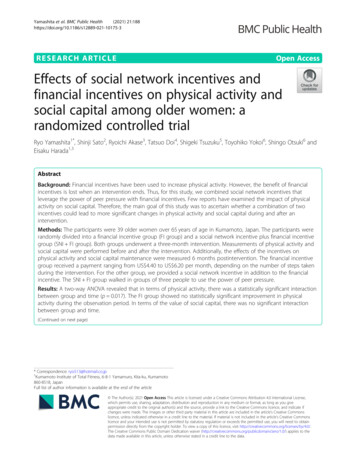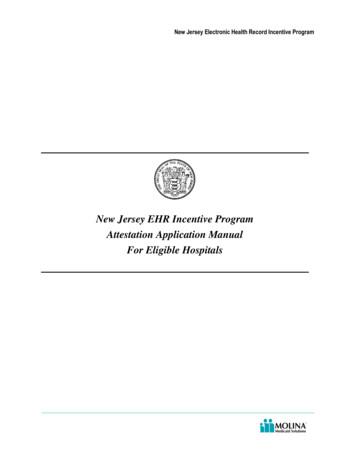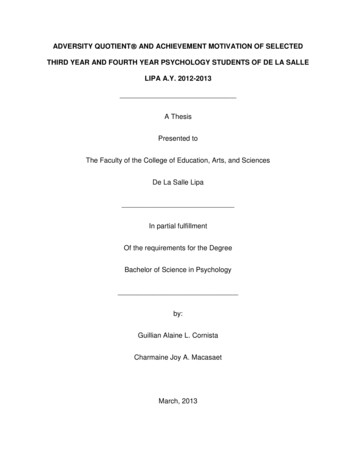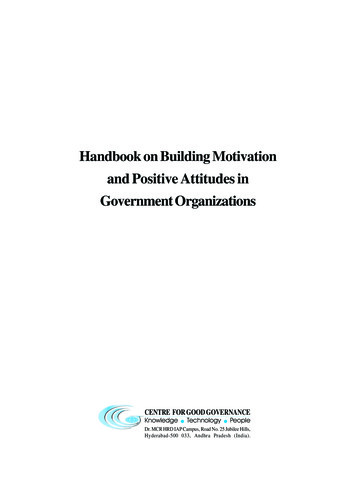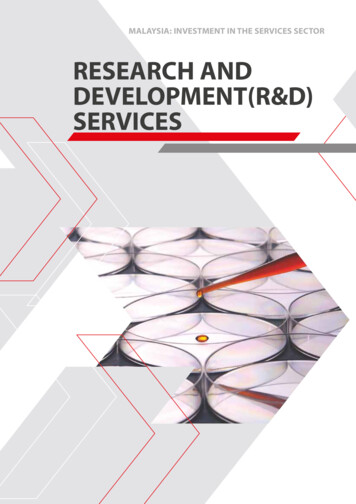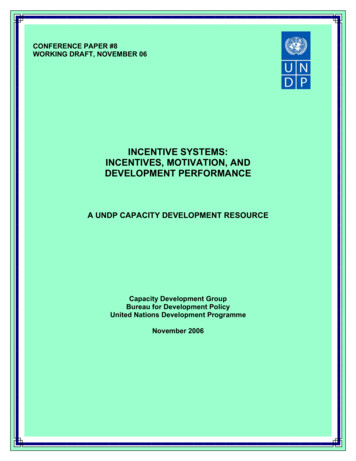
Transcription
CONFERENCE PAPER #8WORKING DRAFT, NOVEMBER 06INCENTIVE SYSTEMS:INCENTIVES, MOTIVATION, ANDDEVELOPMENT PERFORMANCEA UNDP CAPACITY DEVELOPMENT RESOURCECapacity Development GroupBureau for Development PolicyUnited Nations Development ProgrammeNovember 20061
CONTENTSPageACRONYMS AND ABBREVIATIONS3EXECUTIVE SUMMARY4I.Introduction5II.Incentives Strategy in Application7III.Operational Implications9ANNEXES1. Annex 1: 3 Case Studies2. Annex 2: Bibliography222
ACRONYMS AND ECD/DACUNDGUNDPUNESCOUNEVOCUNICEFUSAIDWBIAsia Development BankCapacity 2015Capacity Development GroupDepartment for International Development (UK)European Centre for Development Policy ManagementFood and Agriculture OrganizationGlobal Environment FacilityInternational Labour OrganizationLearning Network on Capacity DevelopmentOrganisation for Economic Cooperation and Development/DevelopmentAssistance CommitteeUnited Nations Development GroupUnited Nations Development ProgrammeUnited Nations Educational, Scientific, and Cultural OrganizationUnited Nations International Centre for TVETUnited Nations Children FundUnited States Agency for International DevelopmentWorld Bank InstituteAcknowledgmentsThis note has been drafted by Thomas Theisohn (Independent Expert) and Tony Land (Independent Expert).Rasheda Selim provided independent editorial comment. It has benefited from a technical review provided byPhilip Courtnadge (UNDP/Regional Bureau for Asia & Pacific), Dele Olowu (Asia Development Bank), andElizabeth Paul (Asia Development Bank).Contact Information:Conference Paper series Production team, Capacity Development Group/BDP, UNDP:Editor:Researcher:URL:Kanni Wignaraja, kanni.wignaraja@undp.orgDalita Balassanian, dalita.balassanian@undp.orgwww.capacity.undp.org3
EXECUTIVE SUMMARYIt is possible to distinguish factors that have motivational effects from other capacity elements. Some areinternal, others are external to or “in the environment” of any given system. The question of motivation isinextricably linked with capacity and needs to be analyzed and addressed on all capacity levels: individual,organization and enabling environment.Incentive measures, such as salaries, secondary benefits, and intangible rewards, recognition or sanctions havetraditionally been used to motivate employees to increase performance. Motivators may be positive and/ornegative. Reducing dis-incentives or perverse incentives that favour non-conducive behaviour, can often bemore important than inventing new incentives. Incentive systems reside within organizations, their structure,rules, human resource management, opportunities, internal benefits, rewards and sanctions, etc. Whether basedon perception or reality, organizational incentive systems do have a significant influence on the performance ofindividuals and thus the organization overall. Perhaps the most pervasive structural motivators and incentivesare located at the societal level, such as security, rule of law, investment climate, civil service pay or legislationconducive to civic engagement.Operational implications are in terms ways in which incentives and other motivators can be used to mobilisecapacity and to promote development performance. This is done in relation to the following: How to Stimulate Better Performance in the Public Sector How to retain and attract talent on the Global Labour Market How to encourage local service delivery in remote areas How to encourage poor people to claim their rights How to align aid for capacity developmentThe paper suggests throughout potential strategies and tools to pursue. Three of these are highlighted indedicated boxes.1. Reducing Distortionary Incentives by Aligning Aid Around National Pay ReformCountries are encouraged to promote transitional arrangements over the medium term that provide a frameworkfor long term pay reform linked to public service reform and that encourage external partners to harmonise andalign their support around a national process. Examples include the Selected Accelerated Salary Enhancement(SASE) scheme in Tanzania (see annexes for case study) and the Cambodian approach of establishing prioritymission groups in key ministries.2. Reducing Demotivation And Valuing Non-Material Incentives For Public Service PerformanceEvidence points to a range of demotivating factors besides pay levels and non-material incentives that can havea significant impact on staff motivation and organisational performance. Understanding what makes people andorganisations tick should also be part and parcel of any capacity assessment exercise. A sensible starting pointis to understand and address first and foremost the de-motivating factors. Drivers of Change and Poweranalysis are important tools. Non-material incentives need to be recognized, valued and reinforced.3. Conditional Cash Transfers To Strengthen DemandDemand Side Financing (DSF) offers a potential innovation and is an example of one of several demand sideapproaches being explored across various sectors. Conditional cash transfers provide different entry point to thesame set of problems, which may have potential for addressing them from a fresh standpoint. Also with largeramounts of development financing available there is a tendency to deliver through vertical arrangements. Thepotential of using higher volumes of aid for conditional cash transfers to households needs to be seriouslyconsidered within conducive socioeconomic frameworks.4
I. IntroductionMotivation is a critical dimension of capacity, defined as “the ability of people, institutions and societies toperform functions, solve problems and set and achieve objectives”. Incentives and incentive systems arefundamental to developing capacities and to translating developed capacities into better performance. The focusof this paper is on the incentives and incentive systems that influence motivation and behaviour of people orlarger system performance for pro-poor action and development outcomes. Incentive systems and motivationsare critical for capacity development as they enable individuals and organisations to perform their functionseffectively, efficiently and sustainably.1. Motivation, Incentives and Capacity – concepts, notions and analytical linkages1.1 Motivation and Incentives - definitionsMotivation refers to the initiation, direction, intensity and persistence of behaviour. Incentives on the other handare external measures that are designed and established to influence motivation and behaviour of individuals,groups or organizations. Incentive systems or structures are combinations of several more or less coherentincentives. Motivators include purposive incentives in the above sense but also all other external factors, whichimpact upon peoples or organizations motivation. The term “motivational system” (or structures) can be used torefer to the set of such motivators, more or less persistent in nature, in place at any given time.Motivation can be at different levels – individual, organizational and societal. Individuals are driven by their owndesires and moral believes. Individual motivations may be “internal” or ”intrinsic” motivation (activated from theinside) such as hobbies, caring for children, or voluntary work in society; or they may “external” or“extrinsic”(activated from the outside) motivation, which is nurtured from the outside.Organizational motivation, distinguished from capacity, refers to the internal motivation of an organization.Social motivations derive from the fact that people tend to identify with others and have a sense of belonging togroups. Individuals depend on others and thus have a certain loyalty to the groups they belong to. Socialrelations are governed by formal and informal rules. There are three dimensions of societal motivations – the firstis a sense of fairness: People, groups and organizations want to feel that they are treated fairly compared topeers or competitors. A second dimension is the existence of criteria and authority that stops unfair dealings andthat encourages fair behaviour. A third is the phenomenon of “social pressure. It can be appreciation ordisapproval from superiors, peers or others that the person feels responsible for, for instance children.At any of these levels, there are always internal motivational factors (figure 1). But it should be recognized thatmotivators for improving performance may also come from external sources. For example, for organizations,motivators may reside externally in other organizations and the broader enabling environment. Furthermore,there are interactions of motivations among these three levels – e.g. individual motivations may enhancemotivation of an organization, but organizations also impact on people, such as their staff or clients. Theyinfluence other organizations such as competing businesses or subordinate offices in the public administration.Organization may in many cases also be the prime entry point for motivating larger societal changes, such as inthe case of a tax authority, a Ministry of Education that decides on curricula, or an anti-corruption agency thatpermeates public and private business.Society/EnablingEnvironment Security Rule of law Culture Civicengagement etcOrganization History Mission Culture IncentivesIndividual Intrinsic motivation morals5
1.2. Performance, motivation and capacity – analytical linkagesPerceptions and concerns about development performance usually provide the entry point for thinking aboutcapacity issues. Yet, capacity does not automatically translate into improved performance and betterdevelopment results. To illustrate: a car engine may have all the components to run smoothly, but it would still sitidle without fuel and a driver. By the same token, capacities may be in place, but appropriate incentives need tobe present to put them in high gear and in motion toward the desired development destination.( Boesen,2004)There are various ways of conceiving of motivation in relation to capacity. On the individual and organizationallevels, one can easily conceive of motivation being complementary to capacity. On the individual level, capacityto perform is a combination of personal skills and motivation of people. It can be weakened or fuelled from within(such as changing believes or health) or external incentives (measures in the environment that impact onmotivation). Learning, which is at the centre of individual capacity development, is fundamentally a function ofintrinsic voluntary motivation to acquire knowledge and the means to do so. The capacity of an organization isalso a function of the motivational abilities of its leadership as it is of external conditions such as pay scales inpublic service or investment climate.In larger systems or the enabling environment, the distinction becomes more blurred. Security, rule of law, andland tenure are part and parcel of societal capacity to manage its affairs. What is capacity on one level may workas incentives on another.In any case, it is possible to distinguish factors that have motivational effects from other capacity elements.Some are internal, others are external to or “in the environment” of any given system. The question of motivationis inextricably linked with capacity and needs to be analyzed and addressed on all capacity levels: individual,organization and enabling environment.11See UNDP Practice Notes Capacity Development and Capacity Assessment6
II. Incentives Strategy in Application2.1. Incentives for individual motivationIncentive measures, such as salaries, secondary benefits, and intangible rewards, recognition or sanctions havetraditionally been used to motivate employees to increase performance. Motivators may be positive and/ornegative. Reducing dis-incentives or perverse incentives that favour non-conducive behaviour, can often bemore important than inventing new incentives. Box 1 indicates a menu of options from which incentives can becombined into packages.Box 1: Incentives that impact on motivation of staff Pay, Salaries, “efficiency wages” etc.Direct financial benefits, such as Pension, illness/health/life insurance; allowances (clothing,housing, etc.), subsidies, gain sharing,Indirect financial benefits such as subsidized meals/clothing/ accommodation/ transport,scholarships, tax breaks; etc., deferred compensation such as seniority pay,Flexible schedules, part-time/ temporary work; sabbatical, study leave, holidays, vacation,etc.Work environment/conditions, occupational health, safety, recreational facilitiesAmenities, school access, infrastructure, transport, etc.Job security; Career/ professional development/ training opportunitiesFeedback, coaching, valued by organizationSolidarity, socializing, camaraderie, affection, passionStatus, prestige, recognitionSense of duty, purpose, missionSecurity, opportunities, stability, riskThus incentives can be financial, which come in some form of payment or cash transfers. Some of the financialincentives are direct such as salary, pension, insurance, bonuses, etc. Others are indirect such as subsidizedmeals, clothes or housing. It is important to make a distinction between a proper level of pay and specialincentive pay to reward performance. In the private sector financial incentives are generally associated withbetter performance although perverse impacts can also be observed. Cash awards are shown to have a highervalue where remuneration is low. Conditions in the public sector differ significantly from those in the privatesector (see below).Non-financial incentives come in many forms such as gifts, rewards, travel. Some are more tangible than otherssince they are visible and/or can be compared to financial benefits. Less tangible incentives relate for instance towork flexibility, independence of working, recognition of one’s work, the possibility of advancement. The value ofnon-financial material incentives seems to be perceived as a function of psychological processes.There is also a distinction to be made between formal incentives and informal ones. Formal ones are forinstance salary scales and staff entitlements. Informal ones may also be legitimate depending on the context butcan also represent channels reaping personal benefits through corrupt practices or patronage.There are also a range of distinctions to be made for non-materialistic incentives. Like generally materialisticincentives, non-materialistic incentives can be “self-interested”, such as psychological benefits related to thestatus of power. On the other hand they can be of a genuinely “altruistic” nature, based on own desires andmoral believes.For a long time, it was thought that intrinsic and extrinsic motivations were additive and could easily be combinedto produce optimal performance. Today it is recognized that there are trade offs. Motivations also have adynamic nature. As the context and trends change, people also adapt their views and preferences. Different7
professional groups respond differently. There is an evolution over time where motivations change with age.While the opportunity for travel, for instance, may be very attractive for young, single professionals, it maybecome a burden for a family setting. Motivations and responsiveness to incentives also is a function of gender.2.2. Incentives for organizational motivationsIncentive systems are an important part of organizational motivation and are central to helping diagnosticiansunderstand the forces that drive the organization. Organizational incentives refer to both the reason for staff tojoin an organization, and the way an organization rewards and punishes its staff. Incentive systems canencourage or discourage employee and work group behaviour. Organizations must continually seek ways tokeep their employees and work groups engaged in their work, motivated, efficient and productive. Anorganization’s success can depend on its ability to create the conditions and systems (formal and informal) thatentice the best people to work there. Also, a good incentive system encourages employees to be productive andcreative, fosters loyalty among those who are most productive, and stimulates innovation.Incentive systems reside within organizations, their structure, rules, human resource management, opportunities,internal benefits, rewards and sanctions, etc. Whether based on perception or reality, organizational incentivesystems do have a significant influence on the performance of individuals and thus the organization overall. Astudy of Ghana’s public sector concludes that “The significance of internal factors in creating positiveorganizational cultures suggests that many of the changes needed to transform public organizations could beinitiated by the organizations themselves without substantial external support.”2.3. Incentives and societal motivationPerhaps the most pervasive structural motivators and incentives are located at the societal level, such assecurity, rule of law, investment climate, civil service pay or legislation conducive to civic engagement. Whetheror not an organisation, for instance, is able to achieve its purpose depends not just on only whether it isadequately resourced but on the incentives generated by the way it is resourced under prevailing rules. Many ofthese cannot easily be influenced from the perspective of individuals and organizations, although these play acritical role as change agents.The motivational direction and value of many of the above are directly rooted in the prevailing Governancesystems. This begins with inclusive democracy and a rights-based approach to development. Neither incentivemechanisms nor external interventions for capacity development will bear results unless there is the rule of lawand a proper legal system. A free press and a vibrant civil society serve as watchdogs to deepen inclusivedemocracy, bolster support for the protection of human rights and further check the misuse of incentivemechanisms. Changing organizational culture takes time. Changing societal values, culture and rules of thegame depends on political processes, negotiation, and in many instances is an issue of generations.8
III. Operational ImplicationsThis section explores various ways in which incentives and other motivators can be used to mobilise capacityand to promote development performance. This is done in relation to the following: How to stimulate better performance in the public sector How to retain and attract talent on the global labour market How to encourage local service delivery in remote areas How to encourage poor people to claim their rights How to align aid for capacity development3.1. How to stimulate better performance in the public serviceA systemic reality in many developing countries is that public service incentives are weak. There is the monetaryside: Wages are too low and pay scales that at best are barely sufficient to live off of, are not competitive withthe private sector or do not compensate for postings to remote locations. Wages are too compressed, notreflecting the skills, training, and seniority of management positions as compared with low paid jobs. Further,non-monetary compensation and allowances play a major role in total compensation – benefits such as housingallowances, official cars, pensions, and other retirement benefits often form a large part of total compensation.These factors can contribute to a culture of absenteeism, alternative employment, rent-seeking and lowproductivity often compounded by a system of non-transparent benefits and allowances that discourage ratherthan encourage performance. Donor practices on salary supplements can further distort incentives if notcoordinated.23.1.1. Public service pay reformPay reform poses many challenges. UNDP’s practice note on public administration reform argues that aniterative process, applied with considerable flexibility and pragmatism, with particular attention to sequencing, ismore likely to bear positive results. Pay is a politically sensitive issue and a technically appropriate strategy maynot be feasible in an unstable environment with high political contestation.The degree of stability (institutionalization) and of political contestation (competitiveness) in the political systemis a key factor in determining how public sector pay will be established. Technical, rational decisions are basedon criteria such as productivity, retention, fairness, transparency and affordability. Politically rational implies asimilar set of criteria moderated by political considerations, negotiation and wider political goals. In politicallyreactive decision-making, patronage, little transparency, and political exigencies to diffuse threats to the regimeprevail.As tackling pay regimes presents numerous challenges for political and institutional reasons, the trend in LDCshas been to introduce various forms of performance based incentives, including targeted salary reforms (Box 2).To improve implementation and monitoring of government pay policy, a number of countries have also createdindependent pay and compensation bodies. Malawi established an independent public service remunerationboard to oversee the implementation of the medium term pay policy. The board is composed of 7 eminentindependent citizens. Bangladesh also set up periodic national pay commissions, composed of members fromdifferent organizations, including the private sector. But the latter have not proven very effective: “whenever payincreases are announced with great fanfare, there is a simultaneous jump in the prices of essential commodities,leaving almost everyone in society in dire straits”. (Kahn) But experience shows that pay and compensationreforms cannot be done in isolation from other policies, in particular those related to macro-economic controls,reduction of military expenditures, and measures to reduce corruption and irresponsible management. Otherstrategies included introducing special pay scales for the senior civil service, core functions, special purposeagencies and selective enhanced compensation for technical and professional staff. Despite these variousefforts, most LDCs are still grasping with the many difficulties related to these reforms.9
Box 2 : Performance pay and compensation reforms in Cambodia and AfghanistanIn an attempt to correct the distortionary problems of donor driven salary top ups and project implementation units,Cambodia has now embarked on some far reaching reforms. The government’s Rectangular Strategy now calls for a10-15% per annum increase in civil service pay. Also, the government’s “priority Mission group” scheme is a flexibletool at the disposal of ministries to rapidly increase their capacity to implement priority missions focused on servicedelivery bottlenecks or other strategic tasks. Under this scheme, selected teams of qualified civil servants will receivean adequate remuneration (special monthly allowance ranging from 48 US to 130 US ) in return for goodperformance and adherence to a strict code of ethics as set out in personal service contracts.However, these reforms are not free of problems. There is a risk that the Primary Mission Group initiative triggers aseries of pressures for additional top-ups in other sectors (e.g. police and military). But the greatest risk probablycomes from parallel donor funded incentive schemes. For example, the Public Finance Management Program (PFM)that is supported by several donors also features a merit-based pay initiative for officials responsible for the PFMreform agenda. Levels of incentives are up to three times higher than the national scheme, but only 15% of thecentrally located staff will be entitled to participate in the scheme. There is thus a risk that income inequality within thecivil service will exacerbate, even between various incentive systems.Competition for qualified human resources is more harsh than usual in post-conflict settings, e.g. in Afghanistan,where demand largely exceeds supply. The excess of demand over supply drives up salary and remuneration levelsand causes inconsistencies between wages paid within government and donor funded government programs. InAfghanistan, different solutions were applied to solve these problems. The Afghanistan Reconstruction Trust Fund(ARTF), the EC funded Capacity Building Groups as well as USAID have paid higher salaries for staff who function asadvisors under contract. A component of the ARTF also supports the recruitment and payment of expatriate Afghans.One of the key drivers for structural and functional reforms is the Priority Reform and Restructuring Initiative (PRR).The PRR links enhanced payment to ministries’ initiatives for public sector reform. Amounts can range from US 40 toUS 500 per month. The successes for these reforms are still too early to tell.Sources: Keuleers, Patrick. "Cambodia Mission report", December 2004, Flaman, R. "Afghanistan, Merit basedrecruitment and the public service.The mode of decision-making also varies over time and the approaches to supporting improved public sectorefficiency through better pay policy will be more effective if they take account of these wider political rhythms andthe prevailing political background. Public service pay needs to be distinguished from incentive pay. “The impactof performance pay on motivation is ambivalent: while it appears to motivate a minority of staff, it seems that alarge majority often do not see performance-related pay as an incentive. Job content and career developmenthave been found to be the strongest incentives for public employees. Performance-related pay is unlikely tomotivate a substantial majority of staff, irrespective of the design.33.1.2. Harmonized approachesWhile there are no quick solutions for reforming the public service, there is a general need for harmonizedapproaches, preferably led by national agents, and optimally integrated in the national budget. Tanzania now forseveral years has gained experience with a scheme of ‘Selected Accelerated Salary Enhancement’ (SASE) (seebox 3). The scheme has faced a number of challenges, including a strong egalitarian culture, implementationproblems on government side and reluctance by donors to support the scheme. Yet the scheme combinescharacteristics of a solid and workable transition arrangement that offers valuable lessons to other countries.2UNDP Practice Note on Public Service Reform (2004), and UNDP Conference Paper on CD in Transitions (draft, Nov2006).3OECD, 2005, p. 176-77, quoted from Paul 200610
Box 3: Reducing distortionary incentives by aligning aid around national pay reformThe IssuePay reform in the public sector is technically complex and politically challenging. There are no easy answers and solutionsneed to be part of a wider package of reform measures to promote capacity and performance improvement. These should belocally determined and must balance political and technical considerations. Where public sector pay is low in absolute andrelative terms, where pay scales are compressed and where recruitment and promotion lacks objectivity and transparencypay reform is a critical issue to address. In practice, issues of pay have been addressed piecemeal and in an arbitrarymanner, often lacking sustainability and fairness, and usually breeding resentment and disaffection. External partners havecontributed to this problem through a variety of practices such as establishing enclave PIUs, by providing salary top-ups toproject staff and by providing various material and non-material incentives.Proposed StrategyCountries are encouraged to promote transitional arrangements over the medium term that provide a framework for long termpay reform linked to public service reform and that encourage external partners to harmonise and align their support arounda national process. In so doing, it helps avoids ad-hoc reward arrangements that distort incentives and motivation in thepublic service that can also undermine capacity, while assuring that incentives are in place to encourage performance inareas of priority. Examples include the Selected Accelerated Salary Enhancement (SASE) scheme in Tanzania (see annexesfor case study) and the Cambodian approach of establishing priority mission groups in key ministries. Characteristics of suchschemes include: The process is country driven and is an integral part of a wider public service reform process External partners align their support around the country initiative and pool their resources with those of the government It is part of a medium to long term strategy linked into the budgetary process which can be continuously monitored andadjusted It offers a point of reference for dialogue among partners on pay, capacity and performance Transparent and objective criteria are established to determine the basis for salary enhancement Objective procedures are applied by an independent review board with representation from relevant stakeholders Scheme beneficiaries are regularly monitored and sanctions are invoked in case of non-performance to avoid perceptionof entitlement An exit strategy for external partner support is built in to assure financial sustainabilityThe design of such schemes needs to take particular account of the extent of objectivity (political independence) in therecruitment process, to avoid being captured by special interests. It is important to consider socio-cultural factors related toequity and fairness, and to understand the factors that influence public service behaviour and attitudes with regard toperformance, accountability, equity and pay. A high degree of management and coordination is required to ensure that allparties play their part and that there is strict adherence to time lines and to the overall budgetary framework. In countries thatlack a clear policy commitment to reform or that are unable to sustain the financial implications of higher salaries in the longerterm de
Incentive measures, such as salaries, secondary benefits, and intangible rewards, recognition or sanctions have traditionally been used to motivate employees to increase performance. Motivators may be positive and/or negative. Reducing dis-incentives or perverse incentives that favour non-conducive behaviour, can often be
